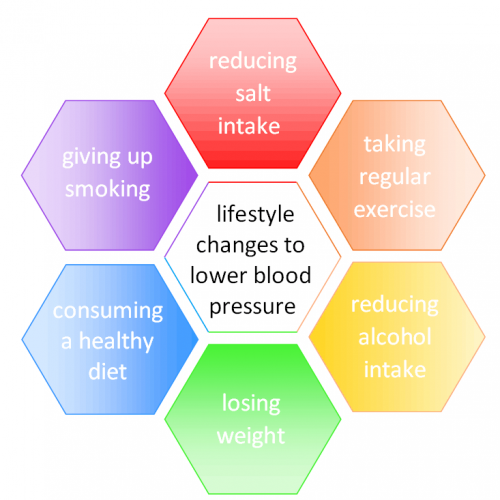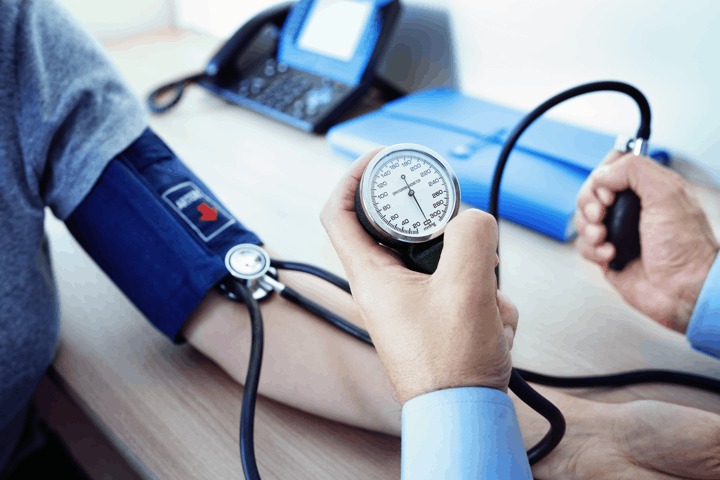Medical Therapy - High Blood Pressure
A number of different factors influence the point at which a patient would benefit from medication to lower blood pressure, but broadly speaking the following apply, based on office readings:

However, in patients with a history of cardiovascular disease, treatment is recommended with readings of ≥130/≥80, and in frail patients the threshold should be individualised.
There are a number of different drug classes which can lower blood pressure. Most patients need more than one drug to lower blood pressure adequately and treatment is usually for life. Patients respond differently and often unpredictably to antihypertensive drugs; one drug class may have no effect on one patient’s blood pressure, whereas a different drug class may lower the blood pressure significantly.
Classes of drug used to lower blood pressure include calcium channel blockers (e.g. amlodipine or diltiazem), ACE inhibitors (e.g. lisinopril or perindopril) and angiotensin receptor blockers (ARBs) (such as candesartan, losartan and valsartan) as well as diuretics (e.g. indapamide). For more resistant blood pressure spironolactone, alpha receptor blockers (e.g. doxazosin), and centrally acting drugs may be prescribed. Beta blockers (e.g. bisoprolol) are rarely used these days.
Each drug class has a specific mechanism of action; many drugs have additional beneficial effects beyond blood pressure lowering, such that the choice of drug will, in part, be influenced by any other co-existing conditions. For example, a patient who has suffered a previous heart attack would benefit from an ACE inhibitor, ARB and beta blocker, while a patient with angina would benefit from a beta blocker or calcium channel blocker.
Acknowledging that the majority of patients will require more than one drug to achieve adequate blood pressure lowering, the latest European guidelines advocate combination drugs as first-line treatment for most patients with hypertension. Furthermore studies have shown that patients generally have a better response to a combination of two drugs at lower doses, compared with one drug at higher doses, and with fewer side-effects.
A recent trial of the drug zilebesiran, delivered by injection rather than in tablet form, showed a reduction in blood pressure of 10-20 mmHg, and the effect lasted for up to six months. Although at the moment the drug is still the subject of clinical trials, this is an exciting development in the treatment of hypertension.
In December 2019 the results of a study called the Hygia Chronotherapy Trial suggested that taking blood pressure medication in the evening instead of the morning led to better blood pressure control, and, better still, a lower risk of heart attack and stroke. However, a more recent study, the Treatment in Morning versus Evening (TIME) trial, has unfortunately demonstrated no benefit to taking blood pressure medication in the evening on cardiovascular outcomes such as heart attack and stroke.
Nonetheless some patients are still encouraged to take their tablets in the evening to help smooth their overall 24 hour blood pressure profile and ensure that they achieve a nocturnal dip.
An important point of note is that once an effective regime has been established to lower blood pressure it should be continued; if the drugs are stopped the blood pressure will swiftly rise to pre-treatment levels or higher, since these drugs work by suppressing high blood pressure, not curing it.
Lifestyle modification
Anyone with raised blood pressure should also be offered advice about lifestyle changes that can help to lower readings, such as:

The single most important dietary change one can make in the presence of hypertension is to reduce salt intake, since this has a significant effect on blood pressure. A diet high in salt alters the balance of fluid either side of the blood vessel walls, leading to an increased volume of fluid in the blood, increasing the pressure exerted against the walls of the blood vessels.
A reduction in daily salt intake from 10g to 6g
would result in 2.6 million fewer deaths per year
worldwide from stroke and coronary artery disease
6g of salt is about one teaspoonful to look at. On nutritional labelling there is often only a figure for sodium rather than salt per se, but the true salt content of a dish is 2.5 times its sodium content, so working from labels alone the goal is a sodium intake of 2.4g or less per day. Thankfully these days many foods have a “traffic light” coding system on the packaging to make it easier to determine which foods to restrict:
High = 1.5g salt or 0.6g sodium per 100g
Medium = 0.3-1.5g salt or 0.1-0.6g sodium per 100g
Low = 0.3g salt or 0.1g sodium per 100g
Some foods have actually been identified as having blood pressure lowering properties, and indeed in the USA there is a diet known as the DASH diet – Dietary Approaches to Stop Hypertension.
Beetroot and garlic in particular have consistently been demonstrated to produce a drop in blood pressure. A 2010 study in the medical journal Hypertension found that drinking beetroot juice reduced systolic blood pressure by up to 5.4 mmHg compared to drinking water, and a meta-analysis published in BMC Cardiovascular Disorders reviewed 11 studies looking in to the blood pressure lowering effects of garlic and found that there was an average reduction in systolic blood pressure of 4.6 mmHg compared with placebo.
Home blood pressure monitors
It is important to keep an eye on home blood pressure readings to ensure that blood pressure is consistently being treated to target.
Home blood pressure monitors range in price and functionality, and there is a large selection available, both online and in stores such as pharmacies. Generally speaking arm monitors tend to be more accurate than wrist monitors, but make sure that the cuff fits the arm comfortably otherwise this will affect the readings.The British and Irish Hypertension Society has a list of monitors which have been validated for home use, which you can find by visiting their website – www.bihsoc.org
Treatment target ranges
The first objective is to lower office blood pressure to <140/<90 in all patients.
If drug treatment is well tolerated, treated office blood pressure values should be targeted to 130/80 or lower, but this is individualised according to the presence/absence of damage to organs as a consequence of high blood pressure, whether or not the patient is diabetic, and whether or not they have kidney disease.
Elderly and frail patients should also have their targets individualised.
In the general population the aim is to reach an office blood pressure range in the
120s/70s
but only if treatment is well tolerated, since some patient groups would require a slightly higher range.

Related links:
Conditions - High Blood Pressure
Blood pressure is the pressure exerted on the walls of the arteries when the heart pumps. Read more
Tests - Ambulatory BP Monitoring
An ambulatory blood pressure monitor will obtain a series of blood pressure readings during the monitoring period (usually 24 hours), which will allow the doctor to determine whether a patient’s blood pressure is consistently high enough to require treatment. Read more
Tests - Echocardiography
Echocardiography is the study of the heart using ultrasound. Similar to a scan of a baby undertaken during pregnancy, an ultrasound probe applied to the chest wall can be used to study the heart. Read more
Tests - Blood and Urine Tests
Blood and urine tests can be very useful for diagnosing a vast number of conditions, and also for checking that a medication is working properly and not causing any adverse effects on the liver or kidneys. Read more
Education and Support - Hypertension
Resources for patients who are concerned about their blood pressure. Read more